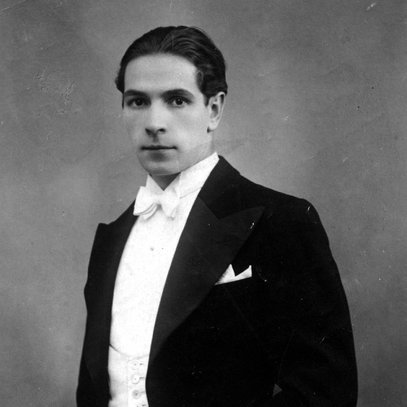Vladas Sipaitis
Vladas Sipaitis (Sipavičius, 1904–1992), a Lithuanian theatre actor, director, representative of the little stage, ballet-dancer, artist and movie actor, was one of the most compelling personalities in the Lithuanian theatre history. In interwar period he also was active on estrade scene. He joined the State Theatre Company in Kaunas, where he appeared in a number of character roles, including Doctor Coppélius in the first independent ballet production (Coppélia by Léo Delibes), etc. He also wrote theatre works. Sipaitis appeared with the Linksmieji broliai (Jolly Brothers) company, performed as a singer of romances, tried his hand in composing national schlagers based on the folk melodies and writing texts for them. In 1932, Sipaitis recorded the first schlagers by Lithuanian composers including Stasys Gailevičius’ tango Kaunas, foxtrot Meilė ir džiazas (Love and Jazz), Sipaitis’ Gegužės burtai (Miracles of May) and Autobusas (The Buss) for Homocord.
Rūta Skudienė
Kaunas (tango)
Meilė ir džiazas (fox-trot)
Biography
Vladas Sipaitis (Sipavičius, 1904 – 1992), a Lithuanian theatre actor, director, representative of the little stage, ballet-dancer, artist and movie actor, was born in Samogitia, near Telšiai. He was one of the most compelling personalities in the Lithuanian theatre history. In interwar period he also was active on estrade scene.
Since 1908, Sipaitis lived in Moscow with his mother, an opera soloist Liudmila Sipavičiūtė-Fedotova. In Moscow he attended F. Korsh Theatre Studio, was a member of the Theatre Company and, in addition, studied painting and sculpture. In 1922, he returned to Lithuania, and taught in Telšiai Gymnasium and the Pedagogical Seminary. He established Samogitian Theatre in Telšiai. In 1924, he joined the State Theatre Company in Kaunas, where he appeared in a number of character roles, including Doctor Coppélius in the first independent ballet production (Coppélia by Léo Delibes), etc. He also wrote theatre works.
In 1936, Sipaitis founded and led the First Drama Studio in Kaunas. He was active as a theatre director and actor in the State Theatre. He also was a founder of the Operetta within the New Musical Theatre, worked as a director of the Operetta of the Kaunas Musical Comedy Theatre as well as actor and designer of the Kaunas State Drama Theatre.
Sipaitis appeared with the Linksmieji broliai (Jolly Brothers) company, performed as a singer of romances, tried his hand in composing national schlagers based on the folk melodies and writing texts for them.
In 1928, Sipaitis acted in the first Lithuanian short film Kareivis – Lietuvos gynėjas (Soldier, the Defender of Lithuania) directed by Jurgis Linartas. In 1931, together with Linartas he directed and acted the protagonist in the first Lithuanian feature film Onytė ir Jonelis (Onytė and Jonelis). He also recorded schlagers, which became the leitmotivs of the film.
In 1932, Sipaitis recorded the first schlagers by Lithuanian composers including Stasys Gailevičius’ tango Kaunas, foxtrot Džiazas ir meilė (Love and Jazz), Sipaitis’ Gegužės burtai (Miracles of May) and Autobusas (The Buss), David Brovin’s The Little Sun (Saulutė) for Homocord. Together with soloists Antanina Dambrauskaitė, Viktoras Orantas, Stasys Pilka and Antanas Komskis he went to record LPs to Berlin.
In 1949, the Soviets deported him to Siberia. Upon his return in 1956, he taught at the Juozas Gruodis Music School in Kaunas and the State Pedagogical Institute in Vilnius, led amateur collectives in Kaunas and Vilnius, acted in Vilnius Old Town Theatre.
He died in Vilnius in 1992.
